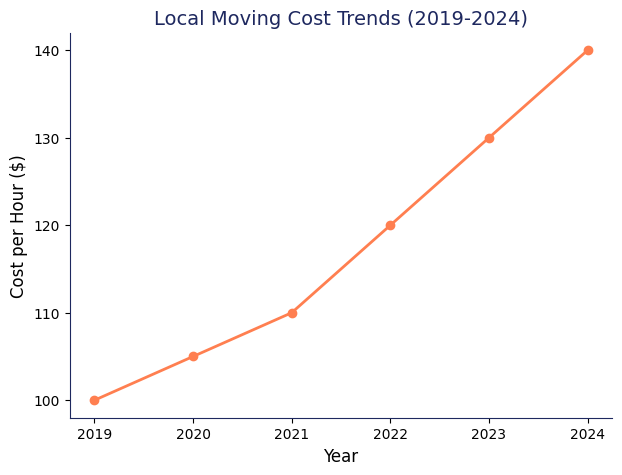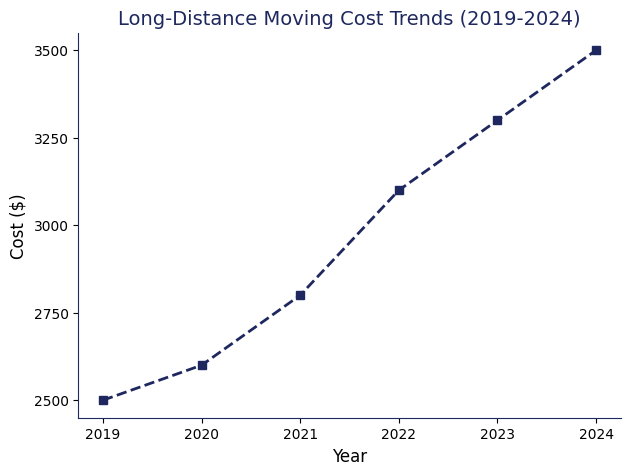
Written, Edited and Fact Checked by Taras Kim
Updated: February 05, 2025
Key Takeaways
- Movers are skilled professionals trained to handle fragile items, heavy furniture, and ensure safe transport, which justifies higher costs.
- Labor costs have risen due to increased wages, with the average mover’s pay rising from $16.23 in 2020 to $19.12 in 2023.
- Additional fees apply for challenging tasks like stair carries, long carries, and handling fragile or heavy items.
- Transportation costs, including fuel, truck maintenance, and insurance, contribute significantly to moving expenses.
- Licensed and insured movers comply with state and federal regulations, ensuring safe and legal services but increasing operational costs.
When people are faced with a move, they are often surprised by the high prices of movers. According to the Bureau of Labor Statistics (BLS), transportation costs, including moving services, have increased by 5.3% over the last year. Now we're going to tell you exactly what movers charge, how the price of their work is formed, and what you can do to make your move cheaper, but comfortable and stress-free.
Table of Contents
Labor Costs: What you are Really Paying for?
Many think movers just carry boxes, but they're skilled professionals. They pack and protect fragile items, handle heavy furniture in tight spaces, securely load trucks, and ensure safe transport—even on long routes.
The price is made up of more than just physical labor. Experience, training, and rising wages also play a big role. The pay for movers has gone up: according to the Bureau of Labor Statistics, the average rate in 2023 is $19.12 per hour, up from $16.23 in 2020. This job requires a lot of stamina, as movers spend long hours lifting heavy things, sometimes in heat or cold. Moving companies train employees to know how to lift goods properly, pack them safely, and avoid damage.
Often moving companies will charge a fee extra for a job that is especially hard for the movers, such as transporting difficult items (e.g. pianos) or working in difficult conditions, are charged separately. If you know these costs in advance, you can budget wisely and avoid surprises.
| Fee Type | When It Applies | Estimated Cost |
|---|---|---|
| Stair Carry Fee | If movers must carry items up/down multiple flights of stairs. | $50–$150 per flight |
| Long Carry Fee | If the truck is parked far from your entrance. | $50–$200+ (based on distance) |
| Storage Fees | If your belongings need to be stored before delivery. | $100–$500 per month |
| Fragile Item Handling | For items like antiques, glassware, and artwork requiring special care. | $100–$500+ (varies by item) |
| Heavy Item Fee | For large/heavy items like safes, pianos, or pool tables. | $100–$1,000 per item |
| Disassembly & Reassembly | If furniture needs to be taken apart and put back together. | $50–$200 per item |
| Packing Services | If movers pack/unpack for you instead of DIY packing. | $200–$1,000+ (based on home size) |
| Last-Minute Booking Fee | If you book a move with little notice, usually under 48 hours. | $100–$500+ |
| Cancellation Fee | If you cancel or reschedule last minute. | $100–$500+ |
“Many customers think that the movers' job is simply loading. But our employees are trained in handling fragile and valuable items and their backgrounds are checked. Not only physical strength is important here, but also skill, precision, accuracy and confidence that each item will arrive without damage,” says Alexander K., head mover of WellKnown Moving.
So why should you hire movers? Many people think that paying for a moving service is too expensive, but in most cases, it's a smart decision. Moving on your own can lead to injuries if you lift heavy furniture incorrectly. Professional movers know how to do it safely. They work faster, pack competently and reduce the moving time. In addition, they properly distribute the cargo in the truck so that nothing shifts or gets damaged during the road.
Transportation and Logistics
In many ways, the cost of moving is also related to transportation costs. Trucks don't just transport furniture; they require costs for fuel, maintenance, insurance, and proper route planning.
One of the key costs is fuel. Trucks consume significantly more of it than passenger cars, especially when fully loaded. In 2024 and 2025, the average price of diesel and gasoline is still high compared to to pre-Covid time, according to data from the U.S. Energy Information Administration (EIA), which led to an increase in transportation costs. This is especially noticeable for long-distance moves, where fuel is a significant part of the budget. But even for local moves, high fuel consumption makes services more expensive.
Truck maintenance and repair is another reason for the high cost. These vehicles are constantly carrying heavy loads, which accelerates tire, brake and engine wear. To avoid breakdowns, companies perform regular maintenance, and repairs can be costly. Due to disruptions in parts supply, repair times have increased, resulting in additional costs. Some companies are forced to rent additional trucks for the duration of repairs, which also affects the price of services.
Insurance is another factor that affects the cost of moving. Moving companies are required to insure the cargo, the transportation itself and their employees. In recent years, the cost of insurance has risen as the number of insurance claims has increased, and new regulations require large payouts for long-distance transportation. This makes the movers' jobs safer for customers, but increases their costs.
Logistics also affects costs. Behind every move is the work of specialists who plan routes, calculate car loads and organize staff. During the season, when the demand for moves increases, the cost of services can rise. Another factor is empty return trips. If a truck has delivered things to another city but returns empty, the company may include part of these expenses in the cost of the service.
Licensing, Insurance and Legal Requirements
In order for your move to go smoothly, it's important to not just find a cheap moving company, but to choose one that operates officially and can guarantee the safety of your belongings. Licensed movers follow state and federal regulations related to safety and insurance. Interstate transportation requires registration with the U.S. Department of Transportation, as well as compliance with Federal Motor Carrier Safety Administration regulations. Some states have additional requirements, so it's a good idea to check to see if the company has all the necessary documents before ordering services. You can check the carrier's registration on the official FMCSA website.
Verify the mover's reliability by checking their rating and accreditation status with the Better Business Bureau (BBB).
Moving companies are required to have insurance that covers possible risks. Liability insurance protects your home and possessions from damage during the move. A cargo policy ensures reimbursement in case your belongings are lost or stolen. In addition, the company should have workers comp insurance that provides payments in case of injuries. Many low-cost movers operate without these safeguards, and if a mishap occurs, the customer may be left without compensation.
By hiring movers without a license, there is a risk of running into scammers. In such a case, things can go missing without a trace and the company will not be held responsible. Lack of insurance means that if the property is damaged, no one will cover the loss. Some unscrupulous movers demand additional payments after loading the belongings, threatening not to return them until the requested amount is paid. The number of such cases has increased in recent years and many people have lost money or property.
To avoid problems, it is important to check if the company is registered with the FMCSA and has a USDOT number. It is helpful to read reviews on independent sites such as Google, Yelp or Thumbtack. Be wary if movers refuse to sign a written contract and demand payment in cash only.
Please be advised that additional charges may apply for payments made via credit card. These fees are levied by banking institutions and payment processors, and are beyond the control of our moving services.
Please note that additional fees may apply when paying by credit card rather than cash. These fees are charged by banking institutions and payment processors and are independent of the moving companies.
Local and Long-distance Moves
The cost of moving depends largely on the distance. If the move is within the same city or state, the price is based on the hours the movers work. When moving to another state or a long distance, kilometers, weight of things and additional services are taken into account. Also for carrying heavy furniture, use of ladders will be charged extra.
| Move Type | Cost Calculation | Average Price (2024) |
|---|---|---|
| Local Move (Within City/State) | Per hour (2–4 movers + truck) | $100–$250 per hour |
| Long-Distance Move (Under 500 miles) | Weight & distance-based | $1,500–$4,500 |
| Long-Distance Move (Over 1,000 miles) | Weight & distance-based | $3,500–$9,000 |
| Cross-Country Move (Over 2,000 miles) | Weight & mileage-based | $6,000–$15,000+ |
The price of a local move usually depends on the number of hours and workers. For example, moving a two-bedroom apartment can take about six hours and cost between $1,200 and $1,800. If moving about 800 miles away, the cost could be between $4,500 and $7,500.
Moving prices have changed in recent years. We've talked about this subject earlier in the article. One of the main reasons has been the rise in fuel prices, which have increased by a certain percentage since 2019. Also, movers' wages have increased due to a shortage of workers, and the demand for moving services has increased noticeably, especially after the pandemic.
To get a better idea of how moving costs have changed from 2019 to 2024, you can take a look at the graphs. It shows how rising fuel prices, higher wages, and increased demand have made both short and long distance moves more expensive.


There are a few things to consider when planning a move. One-city moves typically charge between $100 and $250 per hour, depending on the number of movers and the size of the car. Long-distance moves are more expensive, as the price depends on the distance and weight of things being transported. If you order the service in advance and choose a less busy season, you can save a little money.
Hourly rates for movers vary greatly by region. The cost of movers in Boston will be noticeably higher than the cost of movers in Philadelphia. Research regional prices before making a budget.
Seasonal Prices and Peak Moving Times
Summer moves are more expensive because the demand for movers increases dramatically during this time. Many families try to change homes before the school year starts, and company employees are more likely to move for work. Because of this, there are not always enough trucks available, which raises prices. In addition, the cost of fuel rises in the summer, and with it the price of transportation.
If you want to save money, it is better to move during periods when demand is lower. The most profitable months are from January to March, when prices are minimal. October and November are also considered a good time, as movers are more affordable. But from May through September, prices are the highest. For example, in June, the cost of a local move can be 20-30% higher than in February, and a long-distance move can cost $1,000-3,000 more.
To save money, it is better to plan your move for the middle of the month and weekdays. On weekends and at the end of the month, demand is higher and therefore prices are higher. The most profitable days are Tuesday, Wednesday and Thursday. It is also worth booking services in advance, at least two to three months in advance, especially in summer. If it is possible to change the date of the move, you can get a discount - some companies reduce prices if the client agrees to free windows in their schedule.
How the Cost of Moving is Calculated
When people hire a company to move, one of the main questions is how much it will cost. The answer depends on the calculation method the company uses. There are usually three options: hourly rate, flat rate, or calculation based on the weight of the shipment.
- Hourly Rate: When paying by the hour, the cost depends on the time the movers work. The more people work, the faster but more expensive is the move. The number of things and additional services, such as packing, also affect the price. If three movers work five hours at $150 per hour, the total bill will be $750. With this approach, the company estimates approximately the cost of the move and states all the costs in the quote. Then, after the work is completed and the actual time of work, you make the payment. Often, the cost comes out even slightly lower than the calculated cost.
- Flat Rate: With a flat rate, the company assesses the amount of work in advance and determines the cost. This option is convenient if you want to know in advance how much you have to pay. Often, moving companies perform long distance moves using this approach.
- Weight of the Shipment: Sometimes, often for large long-distance moves, the price is calculated by the weight of the cargo and distance. For example, if you move 4,000 pounds for a thousand miles at 75 cents per pound, the total amount will be $3,000. Sometimes companies offer transportation along with other shipments, which can lower the price. This approach is hardly found among movers anymore, and is more common among delivery companies..
How to Recognize a Scam
Sometimes low moving prices can hide unpleasant surprises. Every year, many people encounter scammers, losing their belongings or incurring large additional expenses. To avoid becoming a victim of fraud, it's important to recognize suspicious companies in advance.
If movers ask for a large upfront payment, this is a worrying sign. Usually reliable companies ask for a deposit, a small advance payment or work without it at all. If they ask you to pay half the amount at once or the entire amount in advance, most likely, it's a scam. Another signal is the absence of a clear calculation of the cost. Unscrupulous companies may first name a low price, and then add hidden fees. Without a written estimate, it's risky to agree to a move.
All interstate movers must have an official USDOT number. If a company doesn't provide one, it means they are not registered and are operating illegally. It's also worth checking to see if the company has a real office and reviews online. Fraudsters often change names and create fake pages to hide their reputation.
If you do encounter a scam, you should file a complaint with the FMCSA and leave a review on sites like Google, Yelp, or Reddit. This will not only help you get justice, but also help warn others.
